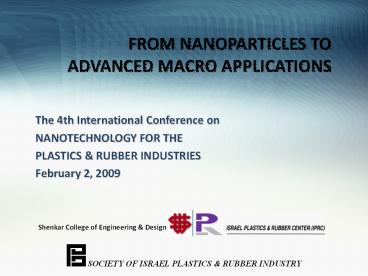FROM NANOPARTICLES TO ADVANCED MACRO APPLICATIONS - PowerPoint PPT Presentation
1 / 37
Title:
FROM NANOPARTICLES TO ADVANCED MACRO APPLICATIONS
Description:
Peel strength: ASTM D-1876. Aluminum adherends unsealed chromic acid anodization ... Lap shear strength: ASTM D-1002. Peel strength: ASTM D-1876 ... – PowerPoint PPT presentation
Number of Views:90
Avg rating:3.0/5.0
Title: FROM NANOPARTICLES TO ADVANCED MACRO APPLICATIONS
1
FROM NANOPARTICLES TO ADVANCED MACRO
APPLICATIONS
- The 4th International Conference on
- NANOTECHNOLOGY FOR THE
- PLASTICS RUBBER INDUSTRIES
- February 2, 2009
Shenkar College of Engineering Design
2
NANO - POSS ENHANCED POLYMER ADHESIVES
- Dr. Ana Dotan
- Prof. Hanna Dodiuk
- Plastics Engineering
- Shenkar
3
Nano enhancement How?
- The small nano particles presents an enormous
surface area - The potential of using nano fillers for
enhancement of adhesive properties is promising
provided - agglomeration is avoided
- good interfacial bonding
- is obtained
4
Nano structuring methodology
The large surface area of nano particles
(hundreds of m2/gr.) leads to interaction with
polymer molecules in the nano level
Functionalization of the nano particles surface
leads to chemical reactions in reactive polymer
systems (thermosetting)
Nano Structured Adhesives Composites
5
Objectives
- Study the effects of
- POSS functionalities
- nano structure of adhesives
- macro properties of adhesives
6
Polyhedral oligomeric silsesquioxanes
- The name silsesquioxane comes from the sesqui,
which means one and a half - General formula (RSiO1.5)n - 1.5 oxygens for
each silicon - The suffix ane represents a hydrocarbon group,
R. - The term polyhedral indicates
- the cage or polyhedron
- nature of the (RSiO1.5)n core.
http//matdl.org/matdlwiki/index.php?titlesoftmat
terPOSS
7
POSS
POSS chemical composition is a hybrid,
intermediate (RSiO1.5) between that of silica
(SiO2) and silicone (R2SiO). POSS molecules can
be thought of as the smallest particles of silica
possible.
8
Structure of silsesquioxane
9
Dimensions and functionality
10
- non reactive end
- groups
- partial
- functionalization
- many reactive
- end groups
11
3-(Aminoethyl)amino)propyl-Heptaisobutyl
substituted
POSS Functionalities
2-(3,4-Epoxycyclohexyl)ethyl)-Heptisobutyl
substituted
Octaphenyl substituted
Glycidoxypropyldimethylsilyloxy- Heptacyclopentyl
substituted
isocyanatopropyldimethylsilyloxy
Heptacyclopentyl substituted
12
POSS nanocomposites
- The incorporation of POSS cage structure into
polymeric networks often results in dramatic
improvements in polymer properties - increase in use temperature
- oxidation resistance
- surface hardening
- improved mechanical properties
- reductions in flammability and heat evolution
13
Dispersion nanostructure of POSS in polymer
matrix
POSS agregates
Top row Electron energy filtered (EF)
compositional images of C and Si. Bottom row
combined SiC elemental map, Si/C elemental map,
and a conventional non-EF bright field image.
POSS molecules are Si rich compared to the
polymer matrix which is C rich compared to POSS
molecules.
http//www7430.nrlssc.navy.mil/facilities/emf/nano
comp.htm
14
Epoxy-POSS nanocomposites
15
Epoxy adhesives
Curing Conditions Stoichiom. Curing Agent Epoxy Charact.
80oC for 8 hrs 7030 w/w polyamidoamine Versamid 140 diglycidyl ether of bisphenol A (DGEBA) Low temp.
150oC for 12 hours 66/34 w/w Polyoxypropylene diamine (Jeffamine D-230) Tetraglycidyl diamino diphenyl methane (TGDDM) Medium temp.
150oC for 12 hours 57/43 w/w Polyoxypropylene triamine (Jeffamine T-403) Tetraglycidyl diamino diphenyl methane (TGDDM) High temp.
16
Methodology
- Nano structuring of epoxy adhesives by a variety
of functionalized POSS particles - Effect on bulk adhesion properties
17
Experimental
- Analysis methods
- Dynamic Mechanical Analysis (DMA)
- Lap shear strength ASTM D-1002. Aluminum
adherends unsealed chromic acid anodization - Peel strength ASTM D-1876. Aluminum adherends
unsealed chromic acid anodization
18
Results
19
Tg of POSS/Low temp. EPOXY
Tg(c)
Tg increases in the range of 2-5 Wt. of POSS
20
Tg of POSS/Med. temp. EPOXY
Tg increases in the range of 0.5-1 Wt. of POSS
21
Tg of POSS/High temp. EPOXY
Tg increases in the range of 2-3 Wt. of POSS
22
EFFECT OF POSS ON STORAGE MODULUS at 25 oC Low
temp. Epoxy
Highest effect at low concentration of reactive
POSS
23
The Effect of POSS on Storage Modulus at
25oC Med. temp. Epoxy
Highest effect at low concentration of POSS
24
The Effect of POSS on Storage Modulus at
25oC High temp. Epoxy
Highest effect at low concentration of POSS
25
Low temp. EPOXY/POSS ADHESIVES Shear and Peel
Strengths
Weight concentration at maximum Tg
26
High temp. epoxy/POSSPeel Strength
Best results for amino, glycidoxy epoxy POSS
27
High temp. epoxy/POSSShear Strength
Best results for 3 Amino POSS No significant
increase in SS
28
Polyurethane-POSS nanocomposites
29
POLYURETHANE ADHESIVES
- Materials
- Trifunctional polypropylene polyether polyol
(Desmophen 1380 BT, Bayer, Germany) - Linear polypropylene ether polyol (Desmophen 1110
BD, Bayer, Germany) - A mixture of diphenylmethane-4,4-diisocyanate
(MDI) with isomers and higher functional
homologues (Desmodur VK 10, Bayer, Germany)
30
EXPERIMENTAL
- Analysis methods
- Differential Scanning Calorimetry (DSC)
- Dynamic Mechanical Analysis (DMA)
- Lap shear strength ASTM D-1002
- Peel strength ASTM D-1876
31
Glass Transition Temperature of PUR - POSS
32
The effect of 1, 3 and 5 wt POSS-octaphenyl on
storage modulus
33
The effect of 1, 3 and 5 wt POSS-glycidoxypropyl
on storage modulus
34
Adhesive Properties Shear Strength
35
Adhesive Properties Peel Strength
36
CONCLUSIONS
- The type of the functional groups (reactive/non
reactive) of the POSS nano particles, is the
dominant factor in the formation of the molecular
network and resultant properties - Optimal concentration exists for each functional
derivative of POSS for Tg increase of adhesives
systems - Optimal concentration exists for each functional
derivative of POSS for toughening of adhesives
systems - Only small amounts (lt 5) are needed to cause
significant improvements, due to the large
surface area of nano particles - Excess amounts results in plasticization effect
37
Acknowledgements
- Tehila Efrat Shenkar, UML
- Irena Belinsky - IPRC
- THANK YOU
- FOR THE ATTENTION































